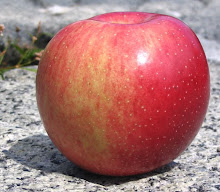 |
Jonathan is very much a classic apple, still justly prized after two hundred years.
This medium-sized apple has a striking appearance: a deep purplish crimson sparsely accented by small light speckles in places. It is clasically round with light ribbing.
Jonathan's flesh is yellow, fragrant, medium-dense, and somewhat tender, though it chunks off nicely.
 The flavor of this apple is very different from the crisp tart-sweet blends of the McIntosh family, though there is both tartness and sweetness plus a nice astringency.
The flavor of this apple is very different from the crisp tart-sweet blends of the McIntosh family, though there is both tartness and sweetness plus a nice astringency.
The flavor is full and cidery, a little spicy with strong pear notes and a hint of melon. I'd like to have some cider made from this variety.
Some sources trace Jonathan back to 1864.

My favorite apple, I love the tartness. And it cooks well, also, but when you make a pie, you need a lot of them!
ReplyDeleteWish I could find these in Virginia! This is the definitive apple!
ReplyDeleteI got some 2 weeks ago at the Carter Family Orchard in Charlottesville, so they are grown here in VA
DeleteJonathan was the first heirloom apple I ever ate, as a six-year-old in my best friend's Wenatchee apple orchard which mostly grew galas, Fuji's, and red delicious. It's still one of my very favourites though I've recognized some shortcomings as I've tried to use it in other ways. The other heirloom I met there was winter banana, which they used as a pollinator and I still love when I can get one. I'm living in Hong Kong currently and the Asians seem to not like punchy apples. Everything I can get here is as bland as a Fuji, except granny smith, which are rare. All the apples here also have a chemical taste that makes your mouth pucker a bit after a few bites. I miss apples. Thanks for all these lovely descriptions.
ReplyDeleteThanks for the note, Alice. Winter B increasingly hard to get around here, but I look for it every fall.
DeleteI'm not surprised. There it was used almost exclusively as a pollinator, and in the new tall spindle systems they use crabapples because they take less maintenance and bloom heavily. I miss the old standard orchards with giant trees. Winter banana is not exciting enough to wow modern tastes, especially if picked green, and it matures late, after red delicious. My aunt and uncle had a red orchard that they eventually tore out and planted blueberries, and it was pollinated with mostly winter bananas. After the reds had been picked and lost their leaves the WB would finally ripen and I had them mostly to myself. Maybe this makes them too late for New England?
DeleteAn old variety, no longer in commercial production here in Ukraine, but still cherished by enthusiasts.
ReplyDeleteBTW, it's an offspring of Esopus Spitzenburg.
Similar in North America, though I would say it's not hard to find at orchards, at least in my part of the country.
DeleteAdam, do you mean big orchards with large number of Jonathan apple trees?
DeleteMost of the really big commercial orchards in the US are in the state of Washington, on the West Coast. They grow, process, and store most of the apples sold here, in large supermarket chains.
DeleteLocally, we are fortunate to have orchards of different sizes, and many grow Jonathan and other heritage varieties. These are often U-Picks and sell through local outlets.
Even very large growers here might have a some trees where they indulge their own interest in apple history and culture.
From time to time, you can come across some ~50 yr old Jonathan apple trees in old orchards/garden plots, that what we've got now here in Ukraine...
DeleteAnd what you've got there in the USA, the land of Jonathan's origin, I would call it a small commercial scale of local importance, and that's cool :-)
P.S.
Delete> BTW, it's an offspring of Esopus Spitzenburg.
Confirmed by that French study (2020).